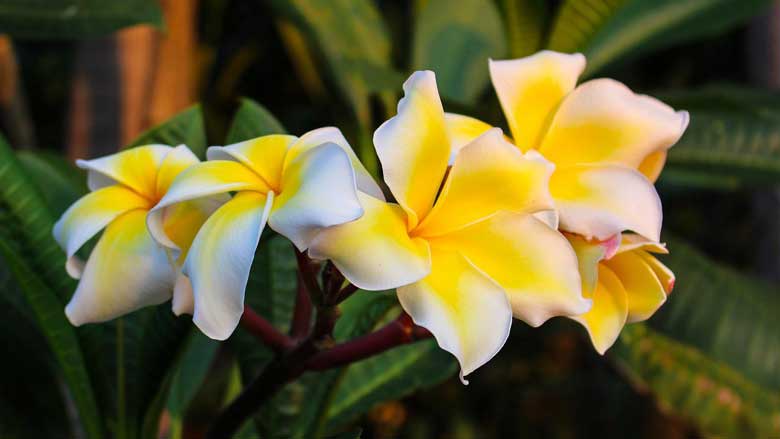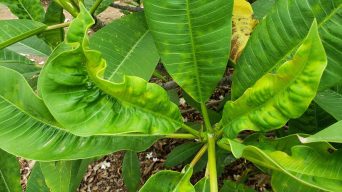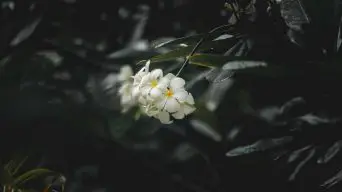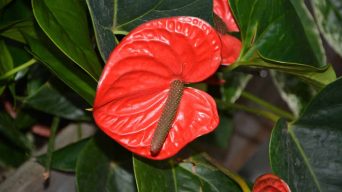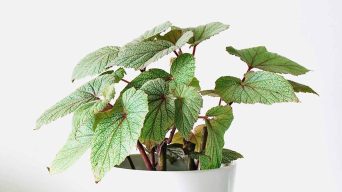Brown spots on Plumeria leaves can be caused by excessive sunlight, watering issues, fertilizer burn, pests, or diseases. To treat, adjust sunlight exposure, correct watering, flush soil, address pests, or use fungicides. Prevent by maintaining plant health and proper care.
Plumeria plants, known as frangipani, are beautiful, fragrant, and relatively easy to care for.
However, like all plants, they are susceptible to pests and disease.
One of the most common problems plumeria growers face is brown spots on the leaves.
There are several reasons why brown spots may appear on plumeria leaves.
Here are a few of the most common and how to treat them.
Understanding the Causes and Remedies for Brown Spots on Your Plumeria Leaves
Plumeria leaves can develop brown spots due to several factors.
These may range from benign causes like natural aging or excessive sun exposure to serious issues like fungal infections.
Identifying the root cause of brown spots on indoor plant leaves is crucial for effective treatment.
Once you pinpoint the cause, you can implement specific measures to address the problem and prevent its recurrence.
Regardless of the underlying reason, there are effective ways to treat these spots and restore your plumeria leaves to health.
The most common causes and solutions include:
1. Excessive Sunlight Affecting Plumeria Plants
Plumerias, known for their need for full sun to partial shade to flourish and produce vibrant blooms, can suffer from overexposure to sunlight.
This is particularly evident during the hottest hours of the day when excessive sun can lead to the development of spots on the leaves.
The delicate and thin nature of plumeria leaves makes them particularly susceptible to sunburn.
Prolonged exposure to direct sunlight initiates the breakdown of chlorophyll in the leaves, a process that contributes to the formation of these spots.
How to Address Excessive Sun Damage
If you think too much sun is the cause of the spots on your plumeria leaves, the best thing to do is move the plant to a location that gets less sunlight.
If possible, find a spot that gets full sun in the morning and partial shade in the afternoon.
You can also try shading the plant with a light-colored cloth or umbrella if you don’t have a spot that gets less sunlight.
2. Watering Issues on Plumeria Plants
Incorrect watering is a common cause of brown spots on plumerias.
Underwatering leads to brown leaves drying out, often due to drought or insufficient watering.
Conversely, overwatering is equally problematic. Even in well-draining soil, persistent wetness of the roots can cause rot, which may ultimately be fatal to the plant.
To mitigate this, it’s important to use well-draining soil, as it helps prevent waterlogging and root rot, common issues in overwatered plumeria plants.
Additionally, using hard water to water plumeria can contribute to developing spots. The high mineral content in hard water accumulates on the leaves, leading to browning.
Chlorine in hard water further exacerbates the issue, damaging the leaves and increasing their susceptibility to browning.
How to Address Watering Problems
If you think watering problems are causing brown spots on your plumeria leaves, the best thing to do is adjust your watering schedule.
For plumerias that are not getting enough water, water them deeply and regularly.
If you think your Plumeria is being overwatered, allow the soil to dry completely between watering.
It’s also a good idea to test the soil conditions before watering to ensure it is dry.
You can do this by sticking your finger in the soil. If it is dry up to your first joint, it is time to water the plant.
You can also try using filtered or distilled water to prevent the build-up of minerals on the leaves.
You may consider installing a water filter if you live in an area with hard water.
3. Fertilizer Burn
Fertilizer burn is another common cause of brown spots on plants.
This usually happens when you use too much fertilizer or if the fertilizer is too strong.
The symptoms of fertilizer burn include brown patches on the leaves, wilting, and stunted growth.
Fertilizer burn occurs because the excess nutrients in the soil overwhelm the plant’s ability to absorb them.
As a result, the nutrient build-up in the leaves causes them to turn brown.
How to Address Fertilizer Burn
If you think your plant has fertilizer burn, the best thing to do is stop using fertilizer and flush the soil with water.
This will help remove the excess nutrients from the soil and prevent further damage to the plant.
Once you have flushed the soil, use fertilizer again, but use it at half the recommended amount.
4. Pest Infestations
Pests, such as spider mites, mealybugs, and scale insects, can also cause brown specks on plumeria leaves.
These bugs feed on the plant sap, leading to leaf discoloration and death.
Spider mites are small, eight-legged creatures, usually red or brown.
They spin webs on the undersides of leaves and suck out the sap, causing the leaves to turn brown and eventually drop off.
Mealybugs are small, wingless insects covered in a white, mealy substance.
They feed on the plant sap, which can cause the leaves to turn brown and eventually drop off.
Scale insects are small, hard-bodied insects that attach themselves to the stems and leaves of plants.
They suck out the plant’s sap, which can cause brown spots on the leaves.
How to Address a Pest Infestation
You can use various methods to eliminate these pests, such as insecticidal soap, neem oil, or horticultural oil.
You can also try using a mixture of water and dish soap.
Mix 1 tablespoon of dish soap with 1 quart of water and spray it on the affected leaves.
Ensure to do this early morning or evening to prevent the leaves from burning.
You may need to use a pesticide if you have a severe infestation.
5. Diseases Affecting Plumerias
Plumeria leaves are susceptible to various bacterial and fungal diseases, often manifested as brown spots.
Accurate identification of these diseases is crucial for effective treatment.
Notably, the most common conditions leading to spots on plumeria leaves include:
a. Plumeria Rust
Plumeria rust is a fungal disease impacting plumeria plants, primarily affecting the leaves. This fungus spreads through spores carried by wind, water, or inadvertently on clothing and other items in contact with infected leaves. It thrives in humid climates.
Symptoms include small, orange-brown spots on leaf undersides, which enlarge and multiply as the disease worsens. Eventually, the leaves start turning yellow and falling off.
Managing plumeria rust involves promptly removing and destroying affected leaves.
Fungicides, like copper sulfate or sulfur, can be effective treatments.
b. Black Tip Fungus
Black tip fungus is another fungal disease that affects plumerias.
This disease is most commonly found in cold, wet climates.
The first symptom of Black tip fungus is small, black spots on the tips of the leaves.
These spots eventually turn brown and spread down the leaf towards the base.
The fungus also causes the Plumeria leaves to curl and turn yellow.
If left untreated, Black tip fungus can kill a plumeria plant.
To treat Black tip fungus, remove and dispose of all affected leaves.
Spray the plumeria plant with a fungicide.
You will likely need to spray the plant several times to remove the fungus completely.
c. Sooty Mold
Sooty mold is a fungus that grows on the honeydew and is excreted by pests, such as aphids and scale insects.
The honeydew provides the perfect environment for the fungus to grow.
Sooty mold does not directly harm the plant but can cause the leaves to turn brown and eventually drop off.
In addition, sooty mold can also block the pores of the leaves, which prevents the plant from taking in sunlight and carbon dioxide.
To get rid of sooty mold, you first must eliminate the pests that are excreting the honeydew.
This can be done using various methods, such as insecticidal soap or horticultural oil.
Once the bugs are gone, the sooty mold will eventually disappear.
d. Bacterial Blight
Leaves with small, water-soaked lesions that turn brown and crinkle are symptomatic of bacterial blight.
The bacteria Pseudomonas syringae pv. glycinea can infect plumeria leaves through stomata, natural openings in the leaf surface.
Once the bacteria enter the leaf tissue, they reproduce rapidly and block its vascular system, causing the leaf to wilt and die.
Bacterial blight is more common in humid climates and during wet weather.
Contaminated pruning tools can spread the bacteria, water splashing on leaves, or contact with infected plant material.
To treat bacterial blight, prune away all infected leaves and dispose of them properly.
Disinfect your pruning tools with a 10% bleach solution to avoid spreading the bacteria between each cut.
You can also try spraying the plumeria leaves with a copper-based fungicide or bactericide.
e. Bacterial Leaf Spot
Many bacteria may cause leaf spots, but Pseudomonas cichorii is the most common in plumeria.
This pathogen is spread by wind and rain and can survive on infected plant debris in the soil.
The disease first appears as tiny brown or black spots on the undersides of leaves.
These spots eventually enlarge and may coalesce, causing the leaves to turn brown and drop off.
Pseudomonas cichorii can also infect stems, causing them to blacken and rot.
The best way to control bacterial leaf spots is to keep your plumeria plants healthy and stress-free.
Avoid injuring the plant tissue, which can provide an entry point for the bacteria.
Water your plumeria at the base of the plant, and make sure the leaves are dry before nighttime to minimize the spread of the disease.
Remove and destroy any affected leaves or stems if you see leaf spots.
You can also treat the plant with a copper-based fungicide or bactericide.
6. Physical Damage
Spots on plumeria leaves may be caused by physical damage.
This can happen if the leaves are touched or brushed against something rough.
The spots may also be caused by wind or hail damage. If the spots are small and only on the surface of the leaves, they will eventually heal on their own.
However, if the spots are large or deep, they may cause the leaves to turn brown and eventually die.
This type of damage is usually not caused by pests or diseases and can be prevented by protecting the leaves from physical damage.
Preventing Spots on Plumeria Leaves
The best way to prevent brown spots on plumerias is to keep the plants healthy and stress-free.
Here are some tips to keep your plumeria plants healthy:
- Water your plumeria regularly, but do not overwater. Plumeria plants prefer well-drained soil and will rot if the roots are constantly wet.
- Fertilize your plumeria monthly during the growing season with a balanced fertilizer.
- Plumeria like full sun, so they get at least 6 hours of sunlight daily. However, be careful not to over-expose them to the sun, which can cause leaf scorch.
- Prune your plumeria regularly to encourage new growth.
- Insects and diseases are more likely to attack stressed or unhealthy plants, so keep an eye out for pests and treat them promptly.
- Keep the area around your plumeria clean and free of debris.
If you follow these tips, you should be able to prevent brown spots on your plumeria leaves.
Final Thoughts
Plumeria plants are beautiful and easy to care for, but they also make excellent houseplants, bringing a touch of nature’s beauty into the home.
Even gardeners with limited experience can successfully nurture these plants, as they don’t require much attention. However, like all plants, they need the proper care to stay healthy.
One problem you may encounter with your Plumeria is brown spots on the leaves. Several things can cause this. However, the most common causes are too much direct sunlight or insufficient water.
If you notice brown spots on your Plumeria leaves, the best thing to do is move the plant to a place with more indirect sunlight. If not enough water causes the spots, make sure to water your plant more often.
Whichever method you choose, keep an eye on your plant and monitor the progress of the spots. With some care, your Plumeria will be healthy and beautiful soon!

